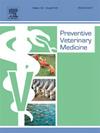荷兰绵羊血清3型蓝舌病的流行率和相关危险因素:第一年流行后农场间和农场内流行率的变化分析
IF 2.4
2区 农林科学
Q1 VETERINARY SCIENCES
引用次数: 0
摘要
2023年9月,蓝舌病毒血清型3 (BTV-3)在荷兰出现。2023年9月至12月期间,数千个养羊场被感染,超过5.5万只羊死亡。本研究旨在确定2023年病媒活跃季节后疫情的最终规模。为了帮助农民为2024年可能出现的卷土重来做好准备,确定了与农场水平存在BTV抗体相关的风险因素,如果存在,则确定了阳性农场中受感染绵羊的比例。从2024年1月至4月(2024年病媒介活跃季节之前)提交给皇家GD用于监测目的的成年羊(N = 387个农场,每个农场13个样本)存档的血清样本被选中并检测btv特异性抗体的存在。根据检测结果计算猪场流行率、血清阳性猪场内流行率和总体(全国)动物水平BTV流行率。此外,同意参与研究的农民在2024年春季接受了关于2023年农场管理的调查。采用适当分布的多变量回归分析,量化潜在危险因素与:(1)羊场btv血清阳性的概率,以及(2)羊场内受感染羊的比例之间的关联。对于后者,将农场内的表观血清流行率与2023年9月至12月期间农场水平记录的死亡率相结合,以纠正受影响农场中死亡的受感染绵羊。绵羊的农场水平血清阳性率估计为47 %(95 % CI: 41-52),国家动物水平血清阳性率估计为10 %(95 % CI: 8-13)。在BTV血清检测呈阳性的农场中,绵羊血清检测呈阳性的中位数百分比为15% %(平均为23% %)。为防止感染而在室内饲养的鸡血清阳性较少(OR: 0.25, 95 % CI: 0.09-0.67)。在血清检测呈阳性的农场中,与冬季剪羊毛相比,7月至9月的夏季剪羊毛与较高的受感染羊比例相关(OR: 2.22, 95 % CI: 1.27-3.86)。虽然发现了一些保护性因素,但它们可能不能完全防止绵羊被感染导致血清阳性。然而,除了疫苗接种之外,这些措施可能为农民提供减少BTV-3在其羊场传播及其后续影响的可能措施。本文章由计算机程序翻译,如有差异,请以英文原文为准。
Seroprevalence of Bluetongue serotype 3 and associated risk factors in Dutch sheep: An analysis of the variation of between-and within-farm prevalences following the first epidemic year
In September 2023, bluetongue virus serotype 3 (BTV-3) emerged in the Netherlands. Thousands of sheep farms became infected and over 55 thousand sheep died between September and December 2023. This study aimed to determine the final size of the epidemic after the vector-active season of 2023. To help farmers prepare for possible resurgence in 2024, risk factors were identified that were associated with presence of BTV antibodies at farm level, and if so, the proportion of affected sheep in positive farms. Archived serum samples from adult sheep (N = 387 farms; 13 samples per farm) submitted to Royal GD for monitoring purposes between January and April 2024 (prior to the vector active season of 2024) were selected and tested for presence of BTV-specific antibodies. Farm prevalence, within-farm prevalence in seropositive farms and overall (national) animal level BTV prevalence were calculated from the test results. Additionally, farmers that agreed to participate in the study were surveyed in spring 2024 regarding their farm management in 2023. Multivariable regression analyses with appropriate distributions were conducted to quantify associations between potential risk factors and i) the probability of sheep farms being BTV-seropositive, and if so, ii) the proportion of affected sheep within the farm. For the latter, the apparent within-farm seroprevalence was combined with the mortality recorded at farm level between Sept-Dec 2023, to correct for infected sheep that died in affected farms. Farm-level seroprevalence in sheep was estimated at 47 % (95 % CI: 41–52) and the national animal-level seroprevalence was estimated to be 10 % (95 % CI: 8–13). Within BTV seropositive farms, a median percentage of 15 % (mean 23 %) of sheep tested seropositive. Flocks kept indoors to prevent infection were less frequently seropositive (OR: 0.25, 95 % CI: 0.09–0.67). Within seropositive farms, shearing in summer, between July and September, was associated with a higher proportion of affected sheep compared to shearing in winter months (OR: 2.22, 95 % CI: 1.27–3.86). Although several protective factors were found, they might not fully prevent sheep from becoming infected resulting in seropositivity. Nevertheless, these measures likely offer farmers possible measures to reduce the spread and subsequent impact of BTV-3 in their sheep farms, beyond vaccination.
求助全文
通过发布文献求助,成功后即可免费获取论文全文。
去求助
来源期刊

Preventive veterinary medicine
农林科学-兽医学
CiteScore
5.60
自引率
7.70%
发文量
184
审稿时长
3 months
期刊介绍:
Preventive Veterinary Medicine is one of the leading international resources for scientific reports on animal health programs and preventive veterinary medicine. The journal follows the guidelines for standardizing and strengthening the reporting of biomedical research which are available from the CONSORT, MOOSE, PRISMA, REFLECT, STARD, and STROBE statements. The journal focuses on:
Epidemiology of health events relevant to domestic and wild animals;
Economic impacts of epidemic and endemic animal and zoonotic diseases;
Latest methods and approaches in veterinary epidemiology;
Disease and infection control or eradication measures;
The "One Health" concept and the relationships between veterinary medicine, human health, animal-production systems, and the environment;
Development of new techniques in surveillance systems and diagnosis;
Evaluation and control of diseases in animal populations.
 求助内容:
求助内容: 应助结果提醒方式:
应助结果提醒方式:


